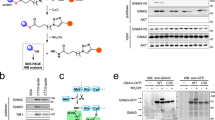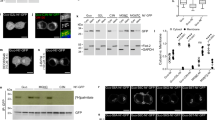Abstract
Palmitoylcarnitine was observed previously to promote differentiation of neuroblastoma NB-2a cells, and to affect protein kinase C (PKC). Palmitoylcarnitine was also observed to increase palmitoylation of several proteins, including a PKC substrate, whose expression augments during differentiation of neural cells—a growth associated protein GAP-43, known to bind phosphatidylinositol 4,5-bisphosphate [PI(4,5)P2]. Since palmitoylated proteins are preferentially localized in sphingolipid- and cholesterol-rich microdomains of plasma membrane, the present study has been focused on a possible effect of palmitoylcarnitine on GAP-43 localization in these microdomains. Palmitoylcarnitine treatment resulted in GAP-43 appearance in floating fractions (rafts) in sucrose gradient and increased co-localization with cholesterol and with PI(4,5)P2, although co-localization of both lipids decreased. GAP-43 disappeared from raft fraction upon treatment with 2-bromopalmitate (an inhibitor of palmitoylating enzymes) and after treatment with etomoxir (carnitine palmitoyltransferase I inhibitor). Raft localization of GAP-43 was completely abolished by treatment with methyl-β-cyclodextrin, a cholesterol binding agent, while there was no change upon sequestration of PI(4,5)P2 with neomycin. GAP-43 co-precipitated with a monomeric form of Gαo, a phenomenon diminished after palmitoylcarnitine treatment and paralleled by a decrease of Gαo in the raft fraction. These observations point to palmitoylation of GAP-43 as a mechanism leading to an increased localization of this protein in microdomains of plasma membrane rich in cholesterol, in majority different, however, from microdomains in which PI(4,5)P2 is present. This localization correlates with decreased interaction with Gαo and suppression of its activity—an important step regulating neural cell differentiation.






Similar content being viewed by others
Abbreviations
- BSA:
-
Bovine serum albumin
- CPT-I:
-
Carnitine palmitoyltransferase I
- MβCD:
-
Methyl-β-cyclodextrin
- OCTN2:
-
Organic cation/carnitine transporter
- PBS:
-
Phosphate buffered saline
- PI(4,5)P2 :
-
Phosphatidylinositol 4,5-bisphosphate
- PKC:
-
Protein kinase C
References
Simons K, Ikonen E (1997) Functional rafts in cell membranes. Nature 387:569–572
Brown DA (2006) Lipid rafts, detergent-resistant membranes, and raft targeting signals. Physiology (Bethesda) 21:430–439
Resh MD (1999) Fatty acylation of proteins: new insights into membrane targeting of myristoylated and palmitoylated proteins. Biochim Biophys Acta 1451:1–16
Resh MD (2004) Membrane targeting of lipid modified signal transduction proteins. Subcell Biochem 37:217–232
Aicart-Ramos C, Valero RA, Rodriguez-Crespo I (2011) Protein palmitoylation and subcellular trafficking. Biochim Biophys Acta 1808:2981–2994
Smotrys JE, Linder ME (2004) Palmitoylation of intracellular signaling proteins: regulation and function. Annu Rev Biochem 73:559–587
Skene JH (1989) Axonal growth-associated proteins. Annu Rev Neurosci 12:127–156
Skene JH, Virag I (1989) Posttranslational membrane attachment and dynamic fatty acylation of a neuronal growth cone protein, GAP-43. J Cell Biol 108:613–624
Strittmatter SM, Valenzuela D, Kennedy TE, Neer EJ, Fishman MC (1990) G0 is a major growth cone protein subject to regulation by GAP-43. Nature 344:836–841
Coggins PJ, Zwiers H (1989) Evidence for a single protein kinase C-mediated phosphorylation site in rat brain protein B-50. J Neurochem 53:1895–1901
Laux T, Fukami K, Thelen M, Golub T, Frey D, Caroni P (2000) GAP43, MARCKS, and CAP23 modulate PI(4,5)P(2) at plasmalemmal rafts, and regulate cell cortex actin dynamics through a common mechanism. J Cell Biol 149:1455–1472
Hope HR, Pike LJ (1996) Phosphoinositides and phosphoinositide-utilizing enzymes in detergent-insoluble lipid domains. Mol Biol Cell 7:843–851
Klopfenstein DR, Tomishige M, Stuurman N, Vale RD (2002) Role of phosphatidylinositol(4,5)bisphosphate organization in membrane transport by the Unc104 kinesin motor. Cell 109:347–358
van Rheenen J, Achame EM, Janssen H, Calafat J, Jalink K (2005) PIP2 signaling in lipid domains: a critical re-evaluation. EMBO J 24:1664–1673
Tong J, Nguyen L, Vidal A, Simon SA, Skene JH, McIntosh TJ (2008) Role of GAP-43 in sequestering phosphatidylinositol 4,5-bisphosphate to raft bilayers. Biophys J 94:125–133
Nałęcz KA, Mroczkowska JE, Berent U, Nałęcz MJ (1997) Effect of palmitoylcarnitine on the cellular differentiation, proliferation and protein kinase C activity in neuroblastoma nb-2a cells. Acta Neurobiol Exp (Wars) 57:263–274
Kerner J, Hoppel C (2000) Fatty acid import into mitochondria. Biochim Biophys Acta 1486:1–17
Lee K, Kerner J, Hoppel CL (2011) Mitochondrial carnitine palmitoyltransferase 1a (CPT1a) is part of an outer membrane fatty acid transfer complex. J Biol Chem 286:25655–25662
Ebert D, Haller RG, Walton ME (2003) Energy contribution of octanoate to intact rat brain metabolism measured by 13C nuclear magnetic resonance spectroscopy. J Neurosci 23:5928–5935
Nałęcz KA, Szczepankowska D, Czeredys M, Kulikova N, Grześkiewicz S (2007) Palmitoylcarnitine regulates estrification of lipids and promotes palmitoylation of GAP-43. FEBS Lett 581:3950–3954
Tamai I, Ohashi R, Nezu J, Yabuuchi H, Oku A, Shimane M, Sai Y, Tsuji A (1998) Molecular and functional identification of sodium ion-dependent, high affinity human carnitine transporter OCTN2. J Biol Chem 273:20378–20382
Tamai I, Ohashi R, Nezu JI, Sai Y, Kobayashi D, Oku A, Shimane M, Tsuji A (2000) Molecular and functional characterization of organic cation/carnitine transporter family in mice. J Biol Chem 275:40064–40072
Januszewicz E, Bekisz M, Mozrzymas JW, Nałęcz KA (2010) High affinity carnitine transporters from OCTN family in neural cells. Neurochem Res 35:743–748
Shinawi M, Gruener N, Lerner A (1998) CSF levels of carnitine in children with meningitis, neurologic disorders, acute gastroenteritis, and seizure. Neurology 50:1869–1871
Szczepankowska D, Nałęcz KA (2003) Palmitoylcarnitine modulates palmitoylation of proteins: implication for differentiation of neural cells. Neurochem Res 28:645–651
Sobiesiak-Mirska J, Nałęcz MJ, Nałęcz KA (2003) Interaction of palmitoylcarnitine with protein kinase C in neuroblastoma NB-2a cells. Neurochem Int 42:45–55
Sobiesiak-Mirska J, Nałęcz KA (2006) Palmitoylcarnitine modulates interaction between protein kinase C betaII and its receptor RACK1. FEBS J 273:1300–1311
Mizgalska JA, Berent U, Mac M, Oestreicher B, De Graan PNE, Gispen WH, Nałęcz MJ, Nałęcz KA (1998) Accumulation of palmitoylcarnitine in neuroblastoma NB-2a cells affects the expression, phosphorylation and localization of B-50 protein. Neurosci Res Commun 22:73–82
Milligan G, Parenti M, Magee AI (1995) The dynamic role of palmitoylation in signal transduction. Trends Biochem Sci 20:181–187
Igarashi M, Strittmatter SM, Vartanian T, Fishman MC (1993) Mediation by G proteins of signals that cause collapse of growth cones. Science 259:77–79
Sudo Y, Valenzuela D, Beck-Sickinger AG, Fishman MC, Strittmatter SM (1992) Palmitoylation alters protein activity: blockade of G(o) stimulation by GAP-43. EMBO J 11:2095–2102
Brockenbrough JS, Korc M (1987) Inhibition of epidermal growth factor binding in rat pancreatic acini by palmitoyl carnitine: evidence for Ca2+ and protein kinase C independent regulation. Cancer Res 47:1805–1810
Lamprecht MR, Sabatini DM, Carpenter AE (2007) Cell Profiler: free, versatile software for automated biological image analysis. Biotechniques 42:71–75
Vokes MS, Carpenter AE (2008) Using CellProfiler for automatic identification and measurement of biological objects in images. Curr Protoc Mol Biol Chapter 14, Unit 14 17
Laemmli UK (1970) Cleavage of structural proteins during the assembly of the head of bacteriophage T4. Nature 227:680–685
Miecz D, Januszewicz E, Czeredys M, Hinton BT, Berezowski V, Cecchelli R, Nałęcz KA (2008) Localization of organic cation/carnitine transporter (OCTN2) in cells forming the blood-brain barrier. J Neurochem 104:113–123
Gray MC, Plant AL, Nicholson JM, May WE (1995) Microenzymatic fluorescence assay for serum cholesterol. Anal Biochem 224:286–292
Gorodinsky A, Harris DA (1995) Glycolipid-anchored proteins in neuroblastoma cells form detergent-resistant complexes without caveolin. J Cell Biol 129:619–627
Sargiacomo M, Scherer PE, Tang Z, Kubler E, Song KS, Sanders MC, Lisanti MP (1995) Oligomeric structure of caveolin: implications for caveolae membrane organization. Proc Natl Acad Sci USA 92:9407–9411
Fukata M, Fukata Y, Adesnik H, Nicoll RA, Bredt DS (2004) Identification of PSD-95 palmitoylating enzymes. Neuron 44:987–996
Arduini A, Mancinelli G, Radatti GL, Dottori S, Molajoni F, Ramsay RR (1992) Role of carnitine and carnitine palmitoyltransferase as integral components of the pathway for membrane phospholipid fatty acid turnover in intact human erythrocytes. J Biol Chem 267:12673–12681
Ramsay RR (2000) The carnitine acyltransferases: modulators of acyl-CoA-dependent reactions. Biochem Soc Trans 28:182–186
Ramsay RR, Gandour RD, van der Leij FR (2001) Molecular enzymology of carnitine transfer and transport. Biochim Biophys Acta 1546:21–43
Kiorpes TC, Hoerr D, Ho W, Weaner LE, Inman MG, Tutwiler GF (1984) Identification of 2-tetradecylglycidyl coenzyme A as the active form of methyl 2-tetradecylglycidate (methyl palmoxirate) and its characterization as an irreversible, active site-directed inhibitor of carnitine palmitoyltransferase A in isolated rat liver mitochondria. J Biol Chem 259:9750–9755
Kerner J, Zaluzec E, Gage D, Bieber LL (1994) Characterization of the malonyl-CoA-sensitive carnitine palmitoyltransferase (CPTo) of a rat heart mitochondrial particle. Evidence that the catalytic unit is CPTi. J Biol Chem 269:8209–8219
Hao M, Mukherjee S, Maxfield FR (2001) Cholesterol depletion induces large scale domain segregation in living cell membranes. Proc Natl Acad Sci USA 98:13072–13077
Adkins EM, Samuvel DJ, Fog JU, Eriksen J, Jayanthi LD, Vaegter CB, Ramamoorthy S, Gether U (2007) Membrane mobility and microdomain association of the dopamine transporter studied with fluorescence correlation spectroscopy and fluorescence recovery after photobleaching. Biochemistry 46:10484–10497
Wu J, McNicholas CM, Bevensee MO (2009) Phosphatidylinositol 4,5-bisphosphate (PIP2) stimulates the electrogenic Na/HCO3 cotransporter NBCe1-A expressed in Xenopus oocytes. Proc Natl Acad Sci USA 106:14150–14155
Strittmatter SM, Valenzuela D, Sudo Y, Linder ME, Fishman MC (1991) An intracellular guanine nucleotide release protein for G0. GAP-43 stimulates isolated alpha subunits by a novel mechanism. J Biol Chem 266:22465–22471
Strittmatter SM, Valenzuela D, Vartanian T, Sudo Y, Zuber MX, Fishman MC (1991) Growth cone transduction: Go and GAP-43. J Cell Sci Suppl 15:27–33
Yang H, Qu L, Ni J, Wang M, Huang Y (2008) Palmitoylation participates in G protein coupled signal transduction by affecting its oligomerization. Mol Membr Biol 25:58–71
Carter BD, Medzihradsky F (1993) Go mediates the coupling of the mu opioid receptor to adenylyl cyclase in cloned neural cells and brain. Proc Natl Acad Sci USA 90:4062–4066
Brown DA, Sihra TS (2008) Presynaptic signaling by heterotrimeric G-proteins. Handb Exp Pharmacol 184:207–260
Koenig JA, Edwardson JM, Humphrey PP (1997) Somatostatin receptors in Neuro2A neuroblastoma cells: operational characteristics. Br J Pharmacol 120:45–51
Arduini A, Denisova N, Virmani A, Avrova N, Federici G, Arrigoni-Martelli E (1994) Evidence for the involvement of carnitine-dependent long-chain acyltransferases in neuronal triglyceride and phospholipid fatty acid turnover. J Neurochem 62:1530–1538
Yang H, Wan L, Song F, Wang M, Huang Y (2009) Palmitoylation modification of Galpha o depresses its susceptibility to GAP-43 activation. Int J Biochem Cell Biol 41:1495–1501
Bates CA, Meyer RL (1996) Heterotrimeric G protein activation rapidly inhibits outgrowth of optic axons from adult and embryonic mouse, and goldfish retinal explants. Brain Res 714:65–75
Li S, Okamoto T, Chun M, Sargiacomo M, Casanova JE, Hansen SH, Nishimoto I, Lisanti MP (1995) Evidence for a regulated interaction between heterotrimeric G proteins and caveolin. J Biol Chem 270:15693–15701
Chisari M, Saini DK, Kalyanaraman V, Gautam N (2007) Shuttling of G protein subunits between the plasma membrane and intracellular membranes. J Biol Chem 282:24092–24098
Jia L, Linder ME, Blumer KJ (2011) Gi/o signaling and the palmitoyltransferase DHHC2 regulate palmitate cycling and shuttling of RGS7 family-binding protein. J Biol Chem 286:13695–13703
Tsutsumi R, Fukata Y, Noritake J, Iwanaga T, Perez F, Fukata M (2009) Identification of G protein alpha subunit-palmitoylating enzyme. Mol Cell Biol 29:435–447
Duncan JA, Gilman AG (1998) A cytoplasmic acyl-protein thioesterase that removes palmitate from G protein alpha subunits and p21(RAS). J Biol Chem 273:15830–15837
Tomatis VM, Trenchi A, Gomez GA, Daniotti JL (2010) Acyl-protein thioesterase 2 catalyzes the deacylation of peripheral membrane-associated GAP-43. PLoS ONE 5:e15045
Acknowledgments
This work was financed by the statutory funds of the Nencki Institute. We would like to thank Dr. Katarzyna Piwocka from the Laboratory of Cytometry of the Nencki Institute of Experimental Biology for advice and the help in flow cytometry experiments, as well as Dr. Tytus Bernaś for assistance with confocal microscopy and help in co-localization analysis.
Author information
Authors and Affiliations
Corresponding author
Rights and permissions
About this article
Cite this article
Tułodziecka, K., Czeredys, M. & Nałęcz, K.A. Palmitoylcarnitine Affects Localization of Growth Associated Protein GAP-43 in Plasma Membrane Subdomains and its Interaction with Gαo in Neuroblastoma NB-2a Cells. Neurochem Res 38, 519–529 (2013). https://doi.org/10.1007/s11064-012-0944-5
Received:
Revised:
Accepted:
Published:
Issue Date:
DOI: https://doi.org/10.1007/s11064-012-0944-5




